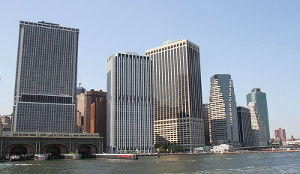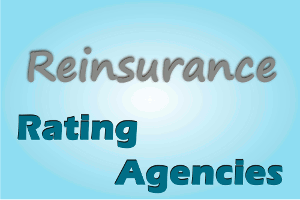Reinsurers and rating agencies
 Standard & Poor’s headquarters in New York © Bjoertvedt, CC BY-SA 3.0 Standard & Poor’s headquarters in New York © Bjoertvedt, CC BY-SA 3.0 |
The credibility of rating agencies has been declining since 1997. They were unable, among others, to predict the Asian crisis, the collapse of Enron or the subprime crisis(1) . The last of their setbacks refers to the "involuntary" announcement of the loss by France of its AAA rating in November 2011, a blunder that had disastrous but short-term consequences on the euro exchange rate.
Tired of having to pay for the mistakes of agencies, which generally do not even have to explain, economic players are no longer on the defensive line. Rating agencies are being increasingly dragged to court with the necessity to face trials. Consequently, Standard & Poor's was sentenced on November 5, 2012 to compensate 13 local communities in Australia(2).
Other actions have been taken, both at judicial and legislative levels. Examples include:
- The vote by the European financial institutions, of measures to reduce the influence of agencies such as:
- the establishment by 2016 of a public rating agency for the euro area,
- the purging by 2020, of European regulations of any reference to ratings,
- recourse to internal analysts to assess country and corporate risks.
- At its last meeting in September 2014, the General Arab Insurance Federation (GAIF) advocates the creation of a rating agency for the Middle East and North Africa region.
In the specific field of reinsurance, agencies have gone on warpath in the early 2000s. Out of the first twenty-five reinsurers in terms of net premiums in 2001, five had the maximum AAA rating. In 2007, this performance went down to just two insurers before vanishing completely in 2013 and 2014.
Agencies’ rating methodologies have certainly evolved over the recent years, but baseline evaluation has more or less remained the same. It is therefore difficult to hold these changes responsible for rating downgrade and consequently insurers’ performance is also to be blamed. The rating process involves an analysis of the company's own data (strategies, results, perspectives,...). The score at the end of this phase is weighted by the score attributed to the reinsurer’s activity. In this context, the current state of bad sovereign ratings may stand as the only favorable factor for reinsurers.
(1) Rating agencies, Atlas Magazine, N° 87, January 2012.(2) Reform of rating agencies, Atlas Magazine, N° 97, January 2013.
Rating’s evolution of the top 25 reinsurers: 2001-2014
| Rating | 2001 | 2007 | 2013 | 2014 |
|---|---|---|---|---|
| AAA | 5 | 2 | - | - |
| AA+ | 3 | - | 1 | 1 |
| AA | 7 | 3 | - | 1 |
| AA- | 5 | 8 | 4 | 6 |
| A+ | 2 | 3 | 7 | 10 |
| A | 1 | 3 | 8 | 3 |
| A- | 1 | 4 | 3 | 1 |
| BBB+ | - | - | 1 | 1 |
| BBB- | 1 | - | - | - |
| BB+ | - | 1 | - | - |
| NR | - | 1 | 1 | 2 |
Reinsurance outlooks
Company-associated outlooks
While rating granting stems from the process described above, the system in use to determine the outlooks related to this rating rests on a substantially different system. Prospects are based on the company’s strategy and its growth potential.
They enable rating agencies to take stock and appraise the path pursued by the company.
Setting the outlook stands as the first clue about the future ratings to be granted to the company as follows:
- Positive: according to the current market trends and to the strategies put in place by the company, with a strong likelihood for the rating to be revised upwards.
- Stable: low probability of any change to the rating.
- Negative: according to the current market trends and to the strategies put in place by the company, with a strong likelihood for the rating to be revised downwards.
Market-associated outlooks
Market’s outlooks are not related to any rating and they can be considered as the "mean value" of the strategies devised by the companies operating in a given market.
These outlooks give information mainly on the expected profitability on the medium or long term basis of a market as follows:
- Positive: good market status, opportunity for growth.
- Stable: general situation relatively good, low probability of evolution.
- Negative: warnings to market players that the strategies applied are likely to lead to a drastic fall in profitability.
The reinsurance market
Despite the relatively good ratings granted to top reinsurers in 2014, the four major rating agencies agree on the outlook of the market that they have changed from stable in 2013 to negative for the current year.
After eight consecutive years of stable outlook, the reinsurance sector has, since the beginning of 2014, been the subject of multiple warnings by rating agencies, which consequently led the market outlook to be degraded from "stable" to "negative."
The first warning shot was launched in January 2014 by Standard & Poor's (S&P). The agency justified its decision to degrade the perspective of the market by the expected decline in reinsurers’ profitability for the years 2014 and 2015. Unfortunately, the following months have confirmed the decision of S&P as the other three main agencies (Moody's, Fitch, and A.M. Best) have assigned a negative outlook to global reinsurance.
To justify the shift in the reinsurance outlook from stable to negative, rating agencies especially pointed to the large number of risks covered and to the market overcapacity, both of which combined would lead to lower profitability.
Risks covered and premium volume
Rating agencies are not impressed by the insurers’ current infatuation with the coverage of more and more risks with increasingly lower and lower premiums. This situation does not allow them to offset losses in a satisfactory fashion.
The downward trend in reinsurance tariffs during the previous renewals has, for a while, drawn the attention of analysts who perceive it as a negative factor that weakens the financial strength of companies in the long run.
Market’s overcapacity
The ever-increasing influx of traditional and alternative capital has created some competition among investors. This situation is likely to destabilize the reinsurance market that has not yet familiarized very much with the practical management of capital from third parties.
Underwriting overcapacity generated by this capital inflow has triggered fierce competition between reinsurers, thus lowering market tariffs.
Agencies are concerned that this constant injection of various capitals might eventually lead to the decline of insurers’ profits.
Ratings of the top 25 reinsurers in 2014
| Country | S& P | A.M. Best | Moody's | Fitch | |
|---|---|---|---|---|---|
Munich Reinsurance | Germany | AA- | A+ | Aa3 | AA- |
Swiss Reinsurance | Switzerland | AA- | A+ | Aa3 | A+ |
Hannover Rueckversicherung AG | Germany | AA- | A+ | - | AA- |
Berkshire Hattaway* | United States | AA+ | A++ | Aa1 | AA+ |
Scor | France | A+ | A | A1 | A+ |
Lloyd's | United Kingdom | A+ | A | - | AA- |
Reinsurance Group of America | United States | AA- | A+ | A1 | A+ |
China Reinsurance | China | - | A | - | - |
Partner Re | Bermuda | A+ | A+ | A1 | AA- |
Everest Reinsurance | Bermuda | A+ | A+ | A1 | - |
Mitsui Sumitomo | Japan | A+ | A+ | A1 | A+ |
Korean Reinsurance | South Korea | A- | A | - | - |
Transatlantic Holdings | United States | A+ | A | A1 | A+ |
Sompo Japan | Japan | A+ | A+ | A1 | - |
Mapfre Re | Spain | A | A | Baa1 | A- |
Tokio Marine Group | Japan | AA- | A++ | Aa3 | AA- |
General Ins. Corp. of India | India | - | A- | - | - |
Allied World Assurance CO. Holdings | Bermuda | A | A | A2 | - |
AXIS Capital Holdings | Bermuda | A+ | A+ | A2 | A+ |
Maiden Re | Bermuda | BBB+ | A- | - | - |
R+V Versicherung AG | Germany | AA- | - | - | - |
XL Re | Bermuda | A+ | A | A2 | A+ |
Toa Re Co. | Japan | A+ | A+ | - | - |
Catlin Group | Bermuda | A | A | - | - |
Caisse Centrale de Réassurance | France | AA | A++ | - | - |
Choosing a rating agency
The choice of a rating agency is usually done after evaluation of a series of criteria related to:
- the nature of the activity: Many tenders contain a "rating" clause, usually specifying the minimum rating to be obtained by an agency to become eligible bidder, and the number of agency or agencies whose ratings have been accepted. The area of activity can, therefore, be considered as one of the most binding criteria set for the choice of a rating agency.
- the price of the service: with rates being disclosed by most agencies only after an initial contact, it makes perfect sense to proceed with this first step considering all pre-selected agencies in order to establish a benchmarking.
- the length of the process: the duration of the procedure varies considerably from one agency to another. It is appropriate to compare the period for each agency to determine which one is more consistent with the company's internal calendar.
- adjustment prospects: recourse policies in use differ according to agencies and are also available without any need to establish prior contact. The agencies’ own trade policies compel them to exhibit some flexibility, with many adjustments being generally offered to the customers before the publication of their ratings. S&P will even give customers the possibility to refuse the public release of their ratings.
- the agency’s target group and its reputation: the purpose of the rating is, among others, to attract investors, hence the need to learn about the scope of the agency’s publication. The volume of its "rating portfolio" also comes into play. Indeed, the more specialized in one area the portfolio is, the more consulted its publications get, the more chances of being known by more and more potential investors.
- the rating methodology: It remains specific to each agency. A preliminary study of these methods and their results (compared to the ratings obtained by similar companies in terms of scope, capacity, strategy, etc.) is likely to give a rough idea of the rating granted at the end of the process. The goal is, of course, to choose the methodology that will provide the most favorable rating.
The study of a sample of the top 50 global reinsurance companies in 2013 gives an idea of the market's preference in terms of rating.
Almost all of them make recourse to Standard & Poor's and A.M. Best (43 and 49 respectively), while only half of the companies prefer to be rated by Fitch and Moody's (respectively 20 and 25).
 It can be concluded that reinsurance professionals consider S&P and A.M. Best as key agencies for their activity.
It can be concluded that reinsurance professionals consider S&P and A.M. Best as key agencies for their activity.
According to the sample examined, the presence of Fitch and Moody's has been less noticed in the markets "outside the United States."
This fact does not undermine the credibility of the rating agencies least preferred by reinsurers, but it would rather tend to emphasize the notoriety, justified or not, of the duo S&P - A.M. Best in the insurance business.
Table of equivalence
Financial soundness ratings are indicators of the company’s capacity to honor its contractual obligations.
Equivalence of financial strength ratings of the main four agencies
| Strength | A.M. Best (1) | S&P (2) | Moody's | Fitch (2) |
|---|---|---|---|---|
Exceptional | A++ / A+ | AAA | Aaa | AAA |
Excellent | A / A- | AA | Aa | AA |
Good | B++ / B+ | A | A | A |
Adequate | B / B- | BBB | Baa | BBB |
Marginal | C++ / C+ | BB | Ba | BB |
Weak | C / C- | B | B | B |
Very weak | - | CCC | Caa | CCC |
Extremely weak | D | - | Ca | CC |
Poor | - | CC | C | C |
Under regulatory supervision | E | R | - | - |
In liquidation | F | - | - | - |
Suspended | S | - | - | - |
(2) ratings from AA to CCC may be modified by the addition of a (+) or (-) sign to show their relative standing within the category concerned.
